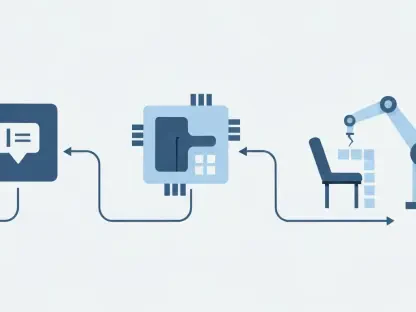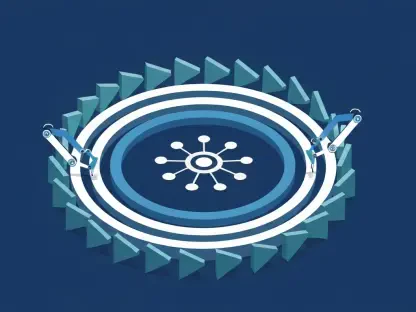In a world where robots are no longer confined to rigid, mechanical forms, a new era of innovation is unfolding with shapeshifting soft robotics leading the charge, offering a glimpse into a future where machines adapt like living organisms. Picture a robot that bends, stretches, and morphs with the grace of a gymnast, navigating unpredictable environments effortlessly. This is not science fiction but a reality crafted by cutting-edge research, offering solutions to challenges that traditional robotics could never address. From healthcare to space exploration, the adaptability of these machines promises to redefine how industries operate in complex, dynamic settings. This review delves into the groundbreaking advancements of soft robotics, exploring their unique features, performance capabilities, and transformative potential across diverse fields.
Core Features of Shapeshifting Soft Robotics
Innovative Materials: Electro-Morphing Gel (e-MG)
At the heart of shapeshifting soft robotics lies a revolutionary material known as electro-morphing gel (e-MG), a soft polymer composite embedded with nanocrystalline conductors. This composition allows robots to achieve extraordinary deformations, enabling them to change shape in ways that mimic natural, fluid movements. Unlike earlier soft materials, e-MG provides a level of flexibility and responsiveness that significantly enhances the robot’s ability to adapt to varied tasks and environments.
The significance of e-MG extends beyond mere flexibility, as it addresses long-standing issues of durability and scalability in soft robotics. With the capacity to endure thousands of actuation cycles without degradation, this material sets a new standard for reliability. Its customizable nature further allows for tailored designs, making it suitable for a wide range of applications, from delicate medical tools to robust industrial components.
Advanced Control: Electric Field Manipulation
Another defining feature of these robots is their use of electric fields for precise control, facilitated by ultralightweight electrodes. This mechanism enables remote manipulation, allowing the robot to bend, stretch, and morph with remarkable accuracy. Compared to traditional methods like magnetic control, electric field systems offer greater efficiency and eliminate the need for bulky, expensive equipment such as electromagnets.
This control method also enhances scalability, as it supports intricate movements without compromising on speed or energy consumption. The ability to execute complex behaviors, such as swinging or navigating tight spaces, positions electric field manipulation as a game-changer in the field. It opens doors to applications where precision and adaptability are paramount, ensuring that soft robots can operate effectively in real-world scenarios.
Performance and Capabilities
The performance of shapeshifting soft robots marks a significant leap forward from their predecessors, particularly in terms of agility and endurance. Demonstrations of a jelly-like humanoid robot swinging along a ceiling highlight the technology’s capacity for large-scale deformations and dynamic motion. Such capabilities are not merely aesthetic but practical, showcasing how these robots can handle tasks that require both flexibility and strength.
Reliability is another area where these robots excel, with consistent functionality proven over extensive actuation cycles. This durability tackles a critical limitation of earlier soft robotic systems, which often struggled with sustained performance. The potential to integrate these soft components with rigid structures further amplifies their utility, creating hybrid systems capable of addressing complex challenges in diverse settings.
Energy efficiency and response time also stand out as key strengths, ensuring that these robots can operate effectively without excessive power demands. Their ability to be customized for specific geometries adds another layer of versatility, allowing for targeted solutions in industries where one-size-fits-all approaches fall short. This combination of traits underscores the practical value of soft robotics in pushing technological boundaries.
Real-World Applications and Impact
Shapeshifting soft robotics are already poised to transform multiple sectors, with healthcare emerging as a primary beneficiary. Their flexibility makes them ideal for minimally invasive procedures, where they can navigate delicate human tissues with precision. Additionally, their potential as adaptive prosthetics offers hope for improved mobility and comfort for patients, marking a significant advancement in medical technology.
Beyond healthcare, space exploration stands to gain immensely from this technology due to the robots’ lightweight and deformable nature. Navigating uneven, unpredictable terrains on distant planets becomes feasible with machines that can adapt to any surface or obstacle. This capability could redefine how missions are conducted, reducing risks and enhancing data collection in extraterrestrial environments.
Wearable technology represents yet another frontier, where soft robots can create adaptive interfaces that conform to the user’s body. From smart clothing to assistive devices, these applications highlight the versatility of the technology in enhancing everyday life. The breadth of impact across such varied fields illustrates why shapeshifting soft robotics are seen as a cornerstone of next-generation innovation.
Challenges and Ongoing Developments
Despite their promise, shapeshifting soft robotics face notable hurdles that must be addressed for widespread adoption. Technical challenges, such as optimizing response times and further improving energy efficiency, remain areas of active research. Overcoming these barriers is essential to ensure that the technology can meet the demands of high-stakes applications without compromise.
Regulatory and market acceptance issues also pose significant obstacles, as integrating such novel systems into existing frameworks requires careful navigation of standards and public perception. Ensuring safety and reliability in critical sectors like healthcare adds another layer of complexity. Research efforts are currently focused on developing robust testing protocols to build trust and facilitate smoother transitions into mainstream use.
Scalability and integration with traditional robotic systems are additional concerns being tackled by ongoing studies. Enhancing the durability of materials like e-MG for long-term use in harsh conditions is a priority, as is creating seamless hybrid solutions. These developments, spanning from the current year to the next few, aim to bridge gaps and position soft robotics as a viable, everyday technology.
Final Thoughts and Next Steps
Looking back, the journey of shapeshifting soft robotics reveals a landscape of immense potential, tempered by challenges that demand innovative solutions. The remarkable adaptability of electro-morphing gel and the precision of electric field control stand as testaments to what has been achieved, reshaping expectations of robotic capabilities. Their impact across healthcare, space, and wearables hints at a future where flexibility is no longer a limitation but a strength.
Moving forward, the focus should shift toward collaborative efforts between researchers, industry leaders, and policymakers to address technical and regulatory hurdles. Investment in material advancements and control system refinements will be crucial over the coming years to unlock the full spectrum of applications. By fostering global partnerships and prioritizing real-world testing, the path can be paved for soft robotics to become an integral part of technological progress, solving problems once thought insurmountable.









